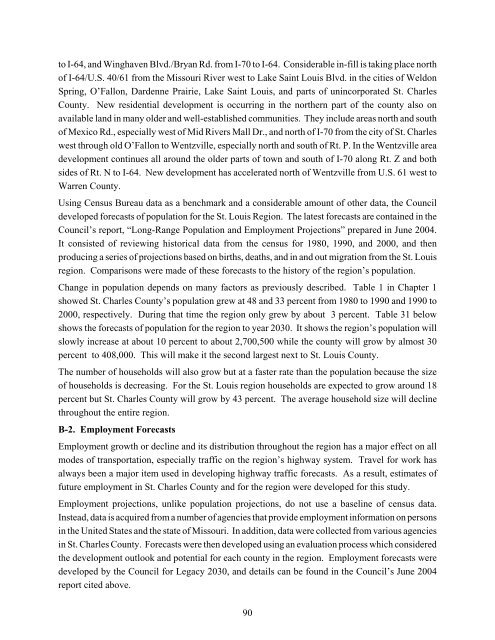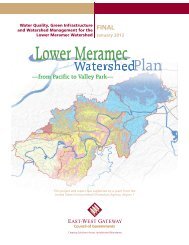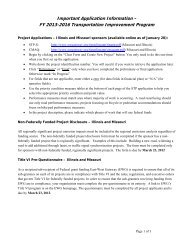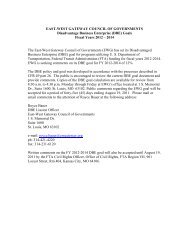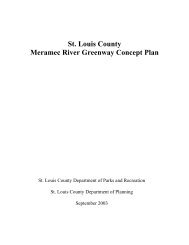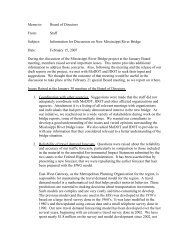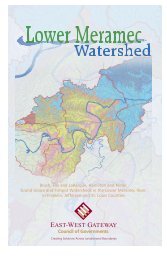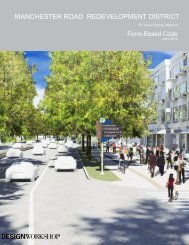St. Charles County Transportation Plan 2030 - East-West Gateway ...
St. Charles County Transportation Plan 2030 - East-West Gateway ...
St. Charles County Transportation Plan 2030 - East-West Gateway ...
You also want an ePaper? Increase the reach of your titles
YUMPU automatically turns print PDFs into web optimized ePapers that Google loves.
to I-64, and Winghaven Blvd./Bryan Rd. from I-70 to I-64. Considerable in-fill is taking place north<br />
of I-64/U.S. 40/61 from the Missouri River west to Lake Saint Louis Blvd. in the cities of Weldon<br />
Spring, O’Fallon, Dardenne Prairie, Lake Saint Louis, and parts of unincorporated <strong>St</strong>. <strong>Charles</strong><br />
<strong>County</strong>. New residential development is occurring in the northern part of the county also on<br />
available land in many older and well-established communities. They include areas north and south<br />
of Mexico Rd., especially west of Mid Rivers Mall Dr., and north of I-70 from the city of <strong>St</strong>. <strong>Charles</strong><br />
west through old O’Fallon to Wentzville, especially north and south of Rt. P. In the Wentzville area<br />
development continues all around the older parts of town and south of I-70 along Rt. Z and both<br />
sides of Rt. N to I-64. New development has accelerated north of Wentzville from U.S. 61 west to<br />
Warren <strong>County</strong>.<br />
Using Census Bureau data as a benchmark and a considerable amount of other data, the Council<br />
developed forecasts of population for the <strong>St</strong>. Louis Region. The latest forecasts are contained in the<br />
Council’s report, “Long-Range Population and Employment Projections” prepared in June 2004.<br />
It consisted of reviewing historical data from the census for 1980, 1990, and 2000, and then<br />
producing a series of projections based on births, deaths, and in and out migration from the <strong>St</strong>. Louis<br />
region. Comparisons were made of these forecasts to the history of the region’s population.<br />
Change in population depends on many factors as previously described. Table 1 in Chapter 1<br />
showed <strong>St</strong>. <strong>Charles</strong> <strong>County</strong>’s population grew at 48 and 33 percent from 1980 to 1990 and 1990 to<br />
2000, respectively. During that time the region only grew by about 3 percent. Table 31 below<br />
shows the forecasts of population for the region to year <strong>2030</strong>. It shows the region’s population will<br />
slowly increase at about 10 percent to about 2,700,500 while the county will grow by almost 30<br />
percent to 408,000. This will make it the second largest next to <strong>St</strong>. Louis <strong>County</strong>.<br />
The number of households will also grow but at a faster rate than the population because the size<br />
of households is decreasing. For the <strong>St</strong>. Louis region households are expected to grow around 18<br />
percent but <strong>St</strong>. <strong>Charles</strong> <strong>County</strong> will grow by 43 percent. The average household size will decline<br />
throughout the entire region.<br />
B-2. Employment Forecasts<br />
Employment growth or decline and its distribution throughout the region has a major effect on all<br />
modes of transportation, especially traffic on the region’s highway system. Travel for work has<br />
always been a major item used in developing highway traffic forecasts. As a result, estimates of<br />
future employment in <strong>St</strong>. <strong>Charles</strong> <strong>County</strong> and for the region were developed for this study.<br />
Employment projections, unlike population projections, do not use a baseline of census data.<br />
Instead, data is acquired from a number of agencies that provide employment information on persons<br />
in the United <strong>St</strong>ates and the state of Missouri. In addition, data were collected from various agencies<br />
in <strong>St</strong>. <strong>Charles</strong> <strong>County</strong>. Forecasts were then developed using an evaluation process which considered<br />
the development outlook and potential for each county in the region. Employment forecasts were<br />
developed by the Council for Legacy <strong>2030</strong>, and details can be found in the Council’s June 2004<br />
report cited above.<br />
90


